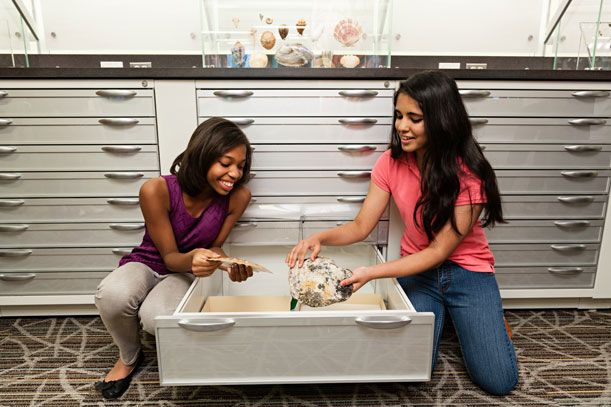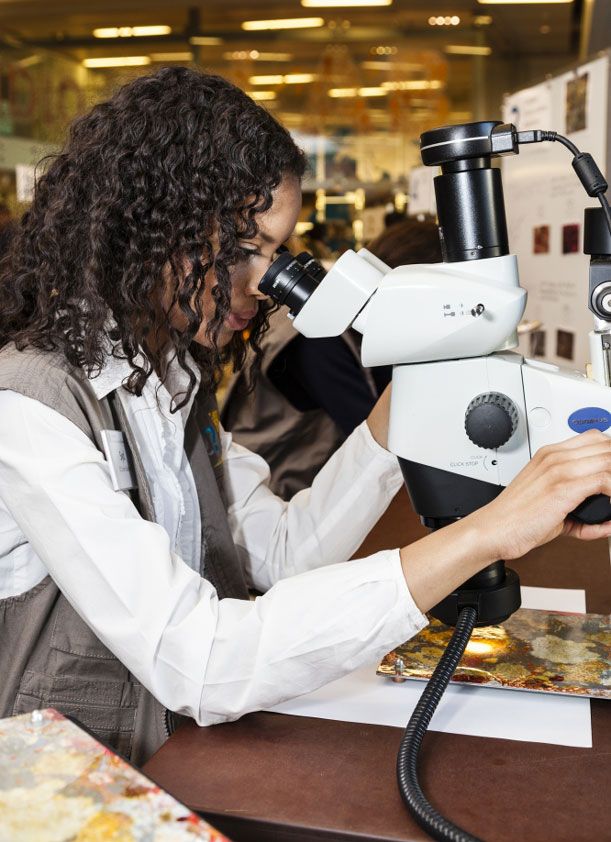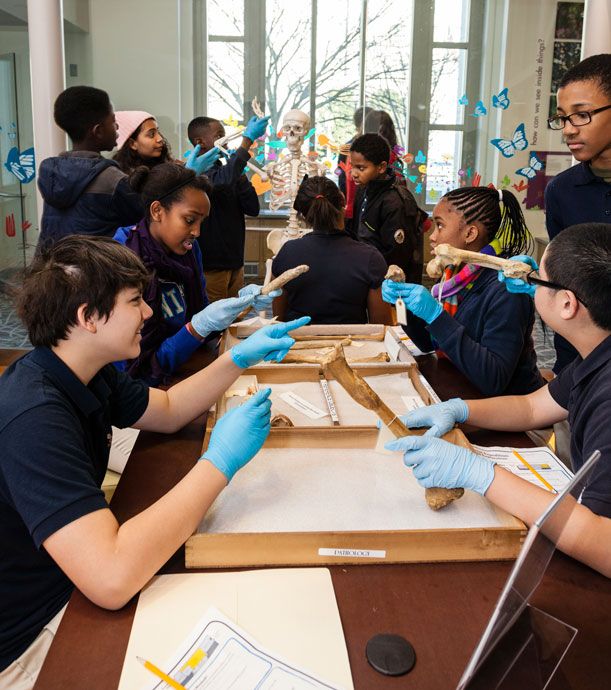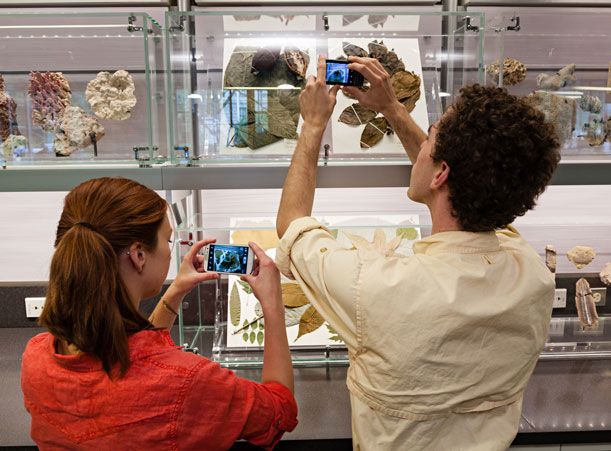A New Education Lab Called Q?rius Aims to Be the Mother of All Curiosity
It’s a quirky way to spell curious, but at Natural History’s Q?rius, the kids are lining up to get in
/https://tf-cmsv2-smithsonianmag-media.s3.amazonaws.com/filer/74/87/7487302e-eb7b-424f-848e-5e6b36403fc5/photo-611.jpg)
Eleanor Roosevelt once said, "I think, at a child's birth, if a mother could ask a fairy godmother to endow it with the most useful gift, that gift would be curiosity." And just as Lewis Carroll took license with the word, making Alice's wonderland world "curiouser and curiouser," the National Museum of Natural History, has coined a new version— Q?rius.
"It's like a highly secure password," says Shari Werb, the museum's assistant director for education and outreach. "It's a word that makes you stop, and try to decode. By then, you're curious."
The name marks a new 10,000-square-foot education space that is packed with stuff that kids (and adults, too) can pick-up, smell, squeeze, and otherwise analyze. Some 6,000 specimens—fossils and plants and minerals and even human bones—from the collections are housed in a setting that the museum is calling "part lab, part collections vault, part DIY garage and part hangout." It features a lab with high-tech microscopes and problem-solving projects, a 100-seat theater for lectures, films and live-feeds from scientific field stations around the world, a loft for just hanging out and socializing, a collections area where objects and specimens can be examined, and a studio classroom for workshops and other activities. All the activities can be logged into a personalized digital repository that approximates a scientist's notebook, complete with notes, drawings and observations.
And the preparation that went into creating Q?rius was actually kid-tested and kid-approved. One of the members of the exhibit's Youth Advisory Board, 18-year-old Olivia Persons, who recently was awarded George Washington University's prestigious Trachtenberg scholarship, was on hand to explain her role.

So you worked here four hours a week? What kinds of things did you do?
Four hours a week, for about a couple of months, working on the space. I work on a lot of design problems and the activities. We helped develop ways that Q?rius can reach out to teens—to actually reach out to our friends. My participation was very thorough. It’s not just one specific thing, or aspect of the Q?rius center, we worked over all.
Did you have any "Aha!" moments?
Definitely. The technology that’s used in the space, my Aha! moment was seeing it come to life. It’s way different on paper, our web designers were telling us how they were going to do this or that. To actually see the results on a computer screen was completely exciting, all of it relevant and accessible.
What’s your field of study?
At George Washington University, I’m majoring in biological anthropology. That is because of the Smithsonian. If not for the Smithsonian, I don’t know where I’d be or what I’d be studying.
Is there a question you’d like to pursue in science?
That’s a good question, I’ve never been asked that before. I’m definitely thinking about that.
Biological anthropology? What is that, and how did you come to that from this experience?
Biological anthropology is the study of humans, evolution and our relations to apes and monkeys. Biological anthropology came from my experience working at the National Zoo, and the Hall of Human Origins. My interest in anthropology had to do with the lab here where they do cases where they try to identify a person through their bones, very much like the TV show “Bones.”
And you’ve done that?
Absolutely.

So tell me about the Lab area. I understand you can handle the bones. What did the bones tell you?
There was one case that turned out to be an African slave who died in rural Virginia. I remember being so excited that you could actually determine if the skeleton belonged to a male or female just by looking at the bones. You know, take away the flesh, the skin and the hair. Also we could figure out and learn, just from her bones, that she was a slave.
From the bones, a slave, how could you tell that?
This lab represents all kinds of anthropology, biological anthropology but also cultural anthropology. They have some cultural items that represent the person who was murdered. So in my example of the African slave, the cultural anthropology was represented by beads that were used as currency in Africa. We were able to narrow down when she was a slave, the time period, and the fact that she had these shells or beads that were used as currency.
And you could tell it was once a girl, or a woman, what told you that?
The pelvic bone.
Interesting. Did you determine her age?
Yes, we did. From the teeth.

The teeth told you her age?
At certain times in a person’s life, the molars and teeth, in general, will come out at a certain time. If you see where the teeth are embedded in the gum, you are able to determine the age.
Now that you’re a student at GW, are you going to continue volunteering here?
I would love to, especially since it’s four metro stops away. I live so close to the museum now, I have no excuse not to.
Let’s say you have a friend who has absolutely no interest in science, who has never been to the museum, ever, and you bring them in here. What are you going to show them first? Would you bring them to Q?rius?
I do that all the time. I bring friends to Q?rius. I would definitely start off here. It shows the depth of the museum.
How so?
Q?rius actually gives visitors a peek, an introduction to every thing in the museum, this is the first time that kids can get a sense of what goes on behind the scenes. That’s what I stress to my friends. There are collections along the walls, in these drawers, showing how much research and science is happening at the museum. There is so, so much more here than what is on display.
Yes, and in most museums you are not allowed to touch. This whole place is so tactile.
Exactly. That’s another reason why this lab is my favorite part of Q?rius. Everything is very technological in here. It’s great, because students love that. This lab is my favorite part because it just grabs you, it’s just you and the bones, and a guide to make sure you’re on the right track. You can see the people here: they are all smiling, happy to be here. I think it’s a good opportunity; most teens do not get a close, personal encounter with bones.
What have you seen kids do when they first hold a human bone in their hand? Are they grossed out or weirdly fascinated?
I know what I did when I held my first human bone.

What did you do?
I was so excited, I was flipping out.
Did you smell it?
No I did not!
Did you hold it firmly or loose in your hand? Were you squeamish? Did you think “Ewww”?
No, because of all the shows like “Bones, “NCIS,” everything is on TV. It was so cool to put a story, a face around it, or at least try. This is what’s inside all of us, this is our skeleton. Very, very science-y. That’s how I would put it.
Q?rius, a new permanent exhibition is now open for business on the ground floor of the Natural History Museum, from 10 to 2 on weekdays and all day during the weekends.
/https://tf-cmsv2-smithsonianmag-media.s3.amazonaws.com/accounts/headshot/Beth_Head_Shot_High_Res-14-v2.png)
/https://tf-cmsv2-smithsonianmag-media.s3.amazonaws.com/accounts/headshot/Beth_Head_Shot_High_Res-14-v2.png)